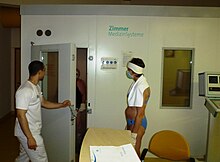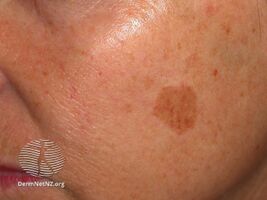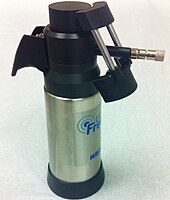Cryotherapy
| Cryotherapy | |
|---|---|
| Other names: Cold therapy | |
Cryotherapy, sometimes known as cold therapy, is the local or general use of low temperatures in medical therapy. Cryotherapy may be used to treat a variety of tissue lesions.[1] The most prominent use of the term refers to the surgical treatment, specifically known as cryosurgery or cryoablation. Cryosurgery is the application of extremely low temperatures to destroy abnormal or diseased tissue and is used most commonly to treat skin conditions.
Cryotherapy is used in an effort to relieve muscle pain, sprains and swelling after soft tissue damage or surgery. It is commonly used to accelerate recovery in athletes post exercise for decades. Scientifically, cryotherapy decreases the temperature of tissue surface to minimize hypoxic cell death, edema accumulation, and muscle spasms, all of which ultimately alleviate discomfort and inflammation.[2] It can be a range of treatments from the application of ice packs or immersion in ice baths (generally known as cold therapy), to the use of cold chambers.
While cryotherapy is widely used, there is little evidence as to its efficacy that has been replicated or shown in large controlled studies. Its long term side effects have also not been studied.[3][4] However, there is a study that concludes that cryotherapy has a positive impact on the short-term recovery of athletes. Cryotherapy helped manage muscle soreness and facilitate recovery within the first 24 hours following a sport-related activity. Athletes who use cryotherapy within the first 24 hours to alleviate pain recovered at a faster rate than athletes who did not use cryotherapy after their sport-related activity.[5]
Cryotherapy chamber

Cryotherapy chamber is an individual, tube-shaped enclosure that covers a person’s body with an open-top to keep the head at room temperature.[6] This is a specific type of low-temperature treatment used to reduce inflammation and painful effects.[7]
It was developed in the 1970s by Japanese rheumatologist Toshima Yamaguchi[8][9] and introduced to Europe, USA and Australia in the 1980s[10][11] and 1990s.[12]
Mechanism of action
When the body is vulnerable to extreme cooling, the blood vessels are narrowed and make less blood flow to the areas of swelling. Once outside the cryogenic chamber, the vessels expand, and an increased presence of anti-inflammatory proteins (IL-10) is established in the blood.[13] Cryotherapy chamber involves exposing individuals to freezing dry air (below −100 °C) for 2 to 4 minutes.[14]
Main uses
Proponents say that cryotherapy may reduce pain and inflammation, help with mental disorders, support exercise recovery performance and improves joint function. Cryotherapy chambers belong to the group of equipment associated with sports rehabilitation and wellness.
- Weight loss[15]
- Reducing anxiety and depression[16]
- Reducing the symptoms of eczema[17]
Cryosurgery
Cryosurgery is the application of extreme cold to destroy abnormal or diseased tissue. The application of ultra-cold liquid causes damage to the treated tissue due to intracellular ice formation. The degree of damage depends upon the minimum temperature achieved and the rate of cooling.[18] Cryosurgery is used to treat a number of diseases and disorders, most especially skin conditions like warts, moles, skin tags and solar keratoses. Liquid nitrogen is usually used to freeze the tissues at the cellular level. The procedure is used often as it is relatively easy and quick, can be done in the doctors surgery, and is deemed quite low risk. If a cancerous lesion is suspected then excision rather than cryosurgery may be deemed more appropriate.[19]
-
Freckle before cryotherapy
-
Freckle after cryotherapy
-
Medical cryotherapy gun
Ice pack therapy
Ice pack therapy is a treatment of cold temperatures to an injured area of the body. Though the therapy is extensively used, and it is agreed that it alleviates symptoms, testing has produced conflicting results about its efficacy.[20][21][22][23]
An ice pack is placed over an injured area and is intended to absorb heat of a closed traumatic or edematous injury by using conduction to transfer thermal energy. The physiologic effects of cold application include immediate vasoconstriction with reflexive vasodilation, decreased local metabolism and enzymatic activity, and decreased oxygen demand. Cold decreases muscle spindle fiber activity and slows nerve conduction velocity; therefore, it is often used to decrease spasticity and muscle guarding. It is commonly used to alleviate the pain of minor injuries, as well as decrease muscle soreness. The use of ice packs in treatment decreases the blood flow most rapidly at the beginning of the cooling period,[24] this occurs as a result of vasoconstriction, the initial reflex sympathetic activity.
Ice is not commonly used prior to rehabilitation or performance because of its known adverse effects to performance such as decreased myotatic reflex and force production, as well as a decrease in balance immediately following ice pack therapy for 20 minutes.[25] However, if ice pack therapy is applied for less than 10 minutes, performance can occur without detrimental effects. If the ice pack is removed at this time, athletes are sent back to training or competition directly with no decrease in performance.[26]
Cryotherapy following total knee replacement
Total knee replacement (TKR) is a common intervention for patients with end-stage osteoarthritis of the knee. Post-surgical management includes cryotherapy. Cryotherapy may slightly reduce the amount of blood loss and pain. It was generally safe and not associated with any serious adverse events. It may improve the range of movement at the knee in the first one to two weeks after surgery. Potential benefits of cryotherapy on blood loss, postoperative pain, and range of motion may be too small to justify its use, and the quality of the evidence was very low or low for all main outcomes. Well designed randomized trials are required to improve the quality of the evidence. In conclusion, the effectiveness of cryotherapy is unclear.[27]
Cold spray anesthetics
In addition to their use in cryosurgery, several types of cold aerosol sprays are used for short-term pain relief. Ordinary spray cans containing tetrafluoroethane, dimethyl ether, or similar substances, are used to numb the skin prior to or possibly in place of local anesthetic injections, and prior to other needles, small incisions, sutures, and so on. Other products containing chloroethane are used to ease sports injuries, similar to ice pack therapy.
Whole body cryotherapy

It is unclear if whole body cryotherapy (WBC) has any effect on muscle soreness, or improves recovery, after exercise.[12] There is no evidence that whole body cooling effectively treats Alzheimer’s, fibromyalgia, migraines, rheumatoid arthritis, multiple sclerosis, stress, anxiety, or chronic pain as its proponents claim.[28] In fact, whole body cyrotherapy is no more effective than taking a cold shower.[29]
This treatment involves exposing individuals to extremely cold dry air (below −100°C) for two to four minutes. To achieve the subzero temperatures required for WBC, two methods are typically used: liquid nitrogen and refrigerated cold air. During these exposures, individuals wear minimal clothing, which usually consists of shorts for males, and shorts and a crop top for females. Gloves, a woollen headband covering the ears, and a nose and mouth mask, in addition to dry shoes and socks, are commonly worn to reduce the risk of cold-related injury. The first WBC chamber was built in Japan in the late 1970s, introduced to Europe in the 1980s, and has been used in the US and Australia in the past decade.[12]
Adverse effects
Reviews of whole body cryotherapy have called for research studies to implement active surveillance of adverse events, which are suspected of being underreported.[12][30] If the cold temperatures are produced by evaporating liquid nitrogen, there is the risk of inert gas asphyxiation as well as frostbite.[31]
Partial body
Partial body cryotherapy (PBC) devices also exist. If the cold temperatures are produced by evaporating liquid nitrogen, there is the risk of inert gas asphyxiation as well as frostbite.[31]
See also
References
- ↑ Cryotherapy at eMedicine
- ↑ "OpenAthens / Sign in". ProQuest 2275802941. Archived from the original on 28 August 2021. Retrieved 9 March 2021 – via ProQuest.
- ↑ Novella, Steven (28 October 2015). "Whole Body Cryotherapy". Science-Based Medicine. Archived from the original on 20 September 2018. Retrieved 29 July 2017.
- ↑ "Cryosurgery in Cancer Treatment". National Cancer Institute. 9 September 2005. Archived from the original on 30 March 2019. Retrieved 29 July 2017.
- ↑ "OpenAthens / Sign in". search.proquest.com. ProQuest 2275802941. Archived from the original on 28 August 2021. Retrieved 9 March 2021.
- ↑ Bouzigon, Romain; Grappe, Frederic; Ravier, Gilles; Dugue, Benoit (1 October 2016). "Whole- and partial-body cryostimulation/cryotherapy: Current technologies and practical applications". Journal of Thermal Biology. 61: 67–81. doi:10.1016/j.jtherbio.2016.08.009. ISSN 0306-4565. PMID 27712663. Archived from the original on 28 August 2021. Retrieved 16 June 2021.
- ↑ Lombardi, Giovanni; Ziemann, Ewa; Banfi, Giuseppe (2 May 2017). "Whole-Body Cryotherapy in Athletes: From Therapy to Stimulation. An Updated Review of the Literature". Frontiers in Physiology. 8: 258. doi:10.3389/fphys.2017.00258. ISSN 1664-042X. PMC 5411446. PMID 28512432.
- ↑ "Elite Athletes Are Utilizing Cryotherapy For Recovery". patients.scnm.edu. Archived from the original on 7 May 2021. Retrieved 23 February 2021.
- ↑ "Why are people freezing their bodies?". theweek.com. 18 April 2017. Archived from the original on 9 May 2021. Retrieved 23 February 2021.
- ↑ Romuk E, Skrzep-Poloczek B, Wiśniowska B, Owczarek AJ, Choręza P, Sieroń A, Birkner E, Stygar D Biomed Res Int, 2019:2065346, 15 May 2019 Cited by: 1 article | PMID 31223612 | PMCID: PMC6541937
- ↑ The effect of cryotherapy on total antioxidative capacity in patients with active seropositive rheumatoid arthritis. Hirvonen H, Kautiainen H, Moilanen E, Mikkelsson M, Leirisalo-Repo M Rheumatol Int, 37(9):1481–1487, 11 Jul 2017 Cited by: 6 articles | PMID 28698947
- ↑ 12.0 12.1 12.2 12.3 Costello, Joseph T.; Baker, Philip Ra; Minett, Geoffrey M.; Bieuzen, Francois; Stewart, Ian B.; Bleakley, Chris (18 September 2015). "Whole-body cryotherapy (extreme cold air exposure) for preventing and treating muscle soreness after exercise in adults" (PDF). The Cochrane Database of Systematic Reviews. 9 (9): CD010789. doi:10.1002/14651858.CD010789.pub2. PMID 26383887. Archived (PDF) from the original on 27 June 2021. Retrieved 16 June 2021.
- ↑ Lubkowska, Anna; Szyguła, Zbigniew; Chlubek, Dariusz; Banfi, Giuseppe (September 2011). "The effect of prolonged whole-body cryostimulation treatment with different amounts of sessions on chosen pro- and anti-inflammatory cytokines levels in healthy men". Scandinavian Journal of Clinical and Laboratory Investigation. 71 (5): 419–425. doi:10.3109/00365513.2011.580859. ISSN 1502-7686. PMID 21574854. S2CID 37200856. Archived from the original on 13 May 2021. Retrieved 16 June 2021.
- ↑ Douzi, Wafa; Dupuy, Olivier; Tanneau, Maxence; Boucard, Geoffroy; Bouzigon, Romain; Dugué, Benoit (3 July 2019). "3-min whole body cryotherapy/cryostimulation after training in the evening improves sleep quality in physically active men". European Journal of Sport Science. 19 (6): 860–867. doi:10.1080/17461391.2018.1551937. ISSN 1746-1391. PMID 30551730. S2CID 54632568.
- ↑ "CryoStar LIQUID NITROGEN-BASED CRYOTHERAPY CHAMBERS | VACUACTIVUS cryotherapy chambers and weight loss machines". 4 December 2020. Archived from the original on 7 May 2021. Retrieved 21 January 2021.
- ↑ Miller, Elżbieta; Mrowicka, Małgorzata; Malinowska, Katarzyna; Mrowicki, Jerzy; Saluk-Juszczak, Joanna; Kędziora, Józef (April 2011). "Effects of whole-body cryotherapy on a total antioxidative status and activities of antioxidative enzymes in blood of depressive multiple sclerosis patients". The World Journal of Biological Psychiatry. 12 (3): 223–227. doi:10.3109/15622975.2010.518626. ISSN 1814-1412. PMID 21083503. S2CID 11064574. Archived from the original on 16 May 2021. Retrieved 16 June 2021.
- ↑ Klimenko, Taras; Ahvenainen, Siru; Karvonen, Seija-Liisa (June 2008). "Whole-body cryotherapy in atopic dermatitis". Archives of Dermatology. 144 (6): 806–808. doi:10.1001/archderm.144.6.806. ISSN 1538-3652. PMID 18559779.
- ↑ Andrews, Mark D. (15 May 2004). "Cryosurgery for Common Skin Conditions". American Family Physician. 69 (10): 2365–2372. ISSN 0002-838X. PMID 15168956. Archived from the original on 6 January 2019. Retrieved 16 June 2021.
- ↑ "Information about Non-Melanoma Skin Cancers". Skcin – The Karen Clifford Skin Cancer Charity. Archived from the original on 6 January 2019. Retrieved 29 July 2017.
- ↑ Bleakley, Chris; McDonough, Suzanne; MacAuley, Domhnall (2004). "The Use of Ice in the Treatment of Acute Soft-Tissue Injury. A Systematic Review of Randomized Controlled Trials". The American Journal of Sports Medicine. 32 (1): 251–61. doi:10.1177/0363546503260757. PMID 14754753. S2CID 23999521. Archived from the original on 6 January 2019. Retrieved 16 June 2021.
- ↑ Mac Auley, D. C. (July 2001). "Ice therapy: how good is the evidence?". International Journal of Sports Medicine. 22 (5): 379–84. doi:10.1055/s-2001-15656. ISSN 0172-4622. PMID 11510876.
- ↑ Thorsson, O. (28 March 2001). "[Cold therapy of athletic injuries. Current literature review]". Lakartidningen. 98 (13): 1512–13. ISSN 0023-7205. PMID 11330146.
- ↑ Hohenauer E, Taeymans J, Baeyens JP, Clarys P, Clijsen R (2015). "The Effect of Post-Exercise Cryotherapy on Recovery Characteristics: A Systematic Review and Meta-Analysis". PLOS ONE. 10 (9): e0139028. Bibcode:2015PLoSO..1039028H. doi:10.1371/journal.pone.0139028. PMC 4586380. PMID 26413718.
- ↑ Swenson, C; Sward, L; Karlsson, J (1996). "Cryotherapy in Sports Medicine". Scandinavian Journal of Medicine and Science in Sports. 6 (4): 193–200. doi:10.1111/j.1600-0838.1996.tb00090.x. PMID 8896090. S2CID 32962326.
- ↑ Cross, K.M.; Wilson, R.W.; Perrin, D.H. (1996). "Functional Performance Following an Ice Immersion to the Lower Extremity". Journal of Athletic Training. 31 (2): 113–16. PMC 1318440. PMID 16558383.
- ↑ Saam, F.; Seidinger, B; Tibesku, C. O. (2008). "The Influence of Cryotherapy of the Ankle on Static Balance". Sportverletz Sportschaden. 22 (1): 45–51. doi:10.1055/s-2007-963601. PMID 18350484.
- ↑ Adie, Sam; Kwan, Amy; Naylor, Justine M; Harris, Ian A; Mittal, Rajat (12 September 2012). Cochrane Musculoskeletal Group (ed.). "Cryotherapy following total knee replacement". Cochrane Database of Systematic Reviews (9): CD007911. doi:10.1002/14651858.CD007911.pub2. PMID 22972114. Archived from the original on 28 August 2021. Retrieved 16 June 2021.
- ↑ "Whole Body Cryotherapy (WBC): A "Cool" Trend that Lacks Evidence, Poses Risks". www.fda.gov. U.S. Food and Drug Administration. 5 July 2016. Archived from the original on 23 April 2019. Retrieved 6 January 2019.
- ↑ Dunning, Brian (20 November 2015). "Skeptoid #492: Pouring Cold Water on Cryotherapy". Skeptoid. Retrieved 24 October 2020.
[Because] water can remove heat some 25–30 times more effectively than air can,... cold water is just as effective as a hyper-cold cryosauna.
- ↑ Bleakley, Chris; Bieuzen, Francois; Davison, Gareth; Costello, Joseph (March 2014). "Whole-body cryotherapy: empirical evidence and theoretical perspectives". Open Access Journal of Sports Medicine. 5: 25–36. doi:10.2147/OAJSM.S41655. PMC 3956737. PMID 24648779.
- ↑ 31.0 31.1 Staff editors (23 March 2017). "The spread of cryotherapy". The Economist. Archived from the original on 20 September 2017. Retrieved 27 March 2017.
External links
- Cryotherapy at the US National Library of Medicine Medical Subject Headings (MeSH)


